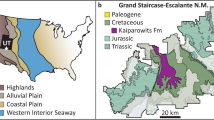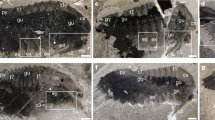Abstract
A NUMBER of ostracods, Cavellina lovatica Zaspelova, with separate receptacles for eggs in the females' brood pouches, have been found during boring operations in the Upper Devonian deposits of the Malaja Vishera district, in the Novgorod region. In the specimens found, at a depth of 76.10 m, there were eleven valves, mostly well preserved; they were large (up to 1,225 µm long) and thin-walled. The brood chamber is separated by a well-marked ridge, running from the ventral to the dorsal margin, and gradually narrowing. Inside the chamber, very shallow, round cavities, which we believe to be receptacles for eggs, can be seen (Fig. 1). Some of these are very distinct, although others have somewhat obscured outlines; the walls between them are thickened. The number of receptacles in the valves varies from individual to individual (Table 1). From this it may be seen that the total number of eggs could be as much as 24, although this might vary with individuals between 16 and 24, and this number can differ between the left and the right valves of the same female. The size of these cavities varies between 100 and 120 µm, and this figure might approximate to the diameter of the eggs.
This is a preview of subscription content, access via your institution
Access options
Subscribe to this journal
Receive 51 print issues and online access
$199.00 per year
only $3.90 per issue
Buy this article
- Purchase on Springer Link
- Instant access to full article PDF
Prices may be subject to local taxes which are calculated during checkout
Similar content being viewed by others
References
Egorov, V. G., Ostracody frnskogo jarussa Russkoj Platformy (I. Kloedenellidae, Gostopetkhisdat, Moskva, Leningrad, 1950).
Osnovy Palenologii, Czlenistongije, Trilobitoobrasnyje i Rakoobrasnyje (Gosgeoltekhisdat, Moskva, 1960).
Geol. Soc. Amer., Treatise on Invertebrate Paleontology, Q, Arthropoda 3 (Kansas Univ. Press, Lawrence, Kansas, 1960).
Gramm, M. N., Iskopajenwja fauna i flora Dalnego Vostoka, 41 (Vladivostock, 1969) (in Russian).
Elofson, O., Zool. Bidr. Upps., 19, 215 (1941).
Brady, G. S., and Norman, A. M., Sci. Trans. Roy. Dublin Soc., Series 2, 5, 621 (1896).
Kornicker, L. S., Micropalaeontology, 9, 61 (1963).
Van Morkhoven, F. P. C. M., Post-palaeozoic Ostracoda, 2 (Elsevier, Amsterdam, 1963).
Van Veen, J. E., Verh. Geol. Mijnb. Genootsch. Nederland en Kolonien, 9, 317 (1932).
Field, R. A., Senckenbergiana Lethaea, 51, 87 (1966).
Gramm, M. N., Dokl. Akad. Nauk. SSSR, 173, 931 (1967) (in Russian).
Schmidt, G. A., Usp. Sovrem. Biol., 14, 160 (1941) (in Russian).
Ivanova, V. A., in Itogi nauki, Stratigraphija, Paleontologija 1967, 181 (Viniti, Moskva, 1968) (in Russian).
Kesling, R. V., Contrib. Mus. Paleontol. Univ. Mich., 22, 273 (1969).
Author information
Authors and Affiliations
Rights and permissions
About this article
Cite this article
GRAMM, M., EGOROV, G. Late Devonian Cavellina (Ostracoda) with Separate Receptacles for Eggs. Nature 238, 267–268 (1972). https://doi.org/10.1038/238267a0
Received:
Issue Date:
DOI: https://doi.org/10.1038/238267a0
This article is cited by
-
A revised classification of the higher taxa of the Ostracoda (Crustacea)
Hydrobiologia (2005)
-
Functional morphology of Palaeozoic ostracods: phylogenetic implications
Hydrobiologia (2005)
-
The early platycopine dynasty (Ostracoda; Palaeozoic)
Senckenbergiana Lethaea (2003)
-
Die Ostracoden-Sintflut — ein forschungsbericht
Paläontologische Zeitschrift (1975)
Comments
By submitting a comment you agree to abide by our Terms and Community Guidelines. If you find something abusive or that does not comply with our terms or guidelines please flag it as inappropriate.



